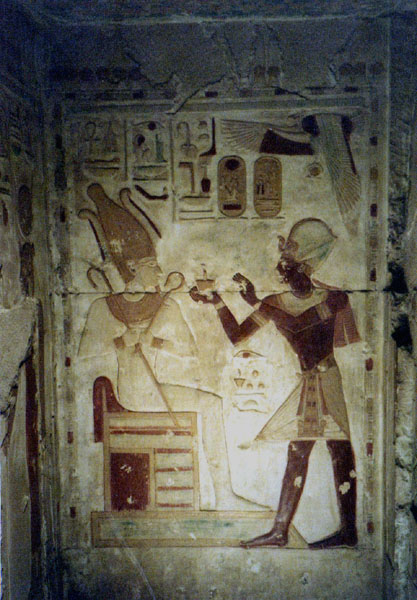 Thursday, January 20, we are up early , groom and go downstairs there there is a nice breakfast at the Abydos House laid out for us. We also enjoy seeing some artwork of the lady of the house that is lovingly displayed on the walls.
Thursday, January 20, we are up early , groom and go downstairs there there is a nice breakfast at the Abydos House laid out for us. We also enjoy seeing some artwork of the lady of the house that is lovingly displayed on the walls.  From the Abydos House it is a short walk to
From the Abydos House it is a short walk to A thousand years later, one of those 1st and 2nd dynasty tombs was mistaken for the tomb of Osiris and pilgrims would leave offerings to the god at the site. The temple we are visiting was begun by Seti I, (1294-1279 BC) and completed by his son Rameses II. Many later pharaohs put cenotaphs (funerary monument, in the form of a tomb, for one who is buried elsewhere) here in Abydos symbolizing connection between lower and upper Egypt, even though they were buried elsewhere. (Indeed some "New Age" types continue to make pilgrimages here and to Dendera, which we visit later today. However unlike those "modern" would-be Egyptians, there is no indication that reincarnation played any role in ancient Egyptian beliefs.)
There are fragments and traces of earlier temples, sacred lakes and other structures but these are all in poor shape except for this temple built by Seti I. This temple is astonishingly intact, most of it still standing and with the colors on the low relief carvings retaining much of their original brilliance.
In terms of modern tourism, this is Middle
This was the most sacred cult center in ancient times and every ancient Egyptian tried to visit here at least once in their lifetime. (Those who failed to make the journey might place a scene of their visit here on their mortuary temple or tomb walls, which apparently secured the same blessing of Osiris.)
 |
| In this picture of the temple facade, you can see what is original and what is reconstruction. The reconstruction allows you to appreciate the original appearance |
Although the facade of Abydos is restored, but the colors and reliefs are original. Abydos includes many illustrations of the interaction between gods and between the king and the gods. In the second hypostyle hall (a columned and roofed hall) are illustrations of Seti with the gods Horus and Osiris.
 |
| Horus blessing Seti |
 |
| Seti offering a gift to the god Osiris |
Further into the temple are chapels dedicated to Osiris, Horus, Ptah, Amun, Isis, Ra-Horakhty and a divine Pharaoh, Seti himself. Each would have contained a golden statue and a barque for the god. You could spend days here just looking at the walls and struggling to understand what those ancient designers intended us to learn. However, it is interesting to note some of the most important designs are in the interior of the temple where only the king and the high priests would ever see them.
However, for archaeologists and historians, the most important thing here is the king list, which claims to list every king from Menes, through Seti, from the first through 19th Dynasty. A total of 76 kings in all are listed
To the left end of the long corridor there is a depiction of Seti I, and in front of him a young boy, who is his son, who will become Rameses II. The prince is depicted wearing the "side lock" of youth.
 |
| Seti with his son, Rameses |
The other omitted kings may be those whose rule over the entire land was questionable (as in the Intermediate Period when at times more than one king seems to have ruled at the same time).
This is one of three known Kings Lists, and by comparing these, along with other historical documents, Egyptologists have managed to piece together a pretty good record of the rulers
 |
| A small section of the Kings List |
Behind the temple is the Osirieon, where it is said Osiris' head was buried. This is a pit filled with water, right now although many of the columns are visible, but it has yet to pumped out. This was built by Seti I but the legend of Osiris and his being buried there goes back to Old Kindgom and this was the cult center for that god of resurection.
Throughout all of ancient Egyptian history, religion as based on this "resurrection" concept. The reason for the tombs, mortuary temples and mummfication was to preserve the body and the being of the deceased so that he or she could resume life in the next world, as life was in this one.
 |
| Osirieon |
Throughout all of ancient Egyptian history, religion as based on this "resurrection" concept. The reason for the tombs, mortuary temples and mummfication was to preserve the body and the being of the deceased so that he or she could resume life in the next world, as life was in this one.
Pictures from both Abydos and Dendera, which we visit next are here: https://picasaweb.google.com/eloise.hedbor/20110120?authkey=Gv1sRgCI2_lc6XvZ3BNg#

No comments:
Post a Comment